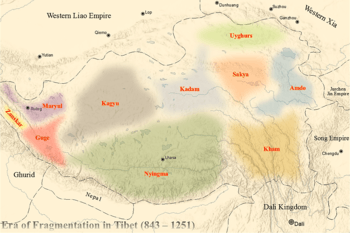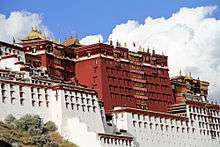Era of Fragmentation

Part of a series on the |
|---|
| History of Tibet |
 |
| See also |
|
|
The Era of Fragmentation (སིལ་ཆད་དུ་འཆད་པ) is a period of Tibetan history in the 9th and 10th century. During this era, the political centralization of the earlier Tibetan Empire collapsed following a civil war between Yumtän (Yum brtan) and Ösung (’Od-srung).[1] The period was dominated by rebellions against the remnants of imperial Tibet and the rise of regional warlords.[2]
Civil war and the decline of imperial Tibet
The last emperor of the unified Tibetan Empire, Langdarma, was assassinated in 842-846, by either a Buddhist hermit or a monk named Pelgyi Dorje of Lhalung.[3][4] The assassination left two possible heirs, Yumtän and Ösung, to fight for the throne, leading to a civil war. The successors of Osung controlled the region of Ngari, while the successors of Yumtän controlled the Ü region.[5] The son of Ösung was Pälkhortsän (Dpal 'khor brtsan) (865–895 or 893–923), who would sire two sons, Trashi Tsentsän (Bkra shis brtsen brtsan) and Thrikhyiding (Khri khyi lding), also called Kyide Nyigön (Skyid lde nyi ma mgon) in some sources. Thrikhyiding migrated to the western Tibetan region of upper Ngari (Stod Mnga ris) and married a woman of high central Tibetan nobility, with whom he founded a local dynasty.[6] This civil war weakened the political authority of the Tibetan monarchy,[7] dissolving Tibet into separate tribes and small kingdoms.[5]
Revolts and warlords
The dissolution of a centralized empire allowed Tibetan peasants, dissatisfied with the political turmoil, to rebel against regional governments. These uprisings split imperial Tibet into a multitude of separate, autonomous kingdoms, each ruled by a local warlord.[5] The warlords constantly fought for political dominance, utilizing private armies and military fortresses.[5] Between 842 and 1247, no central authority was in control of Tibet. The period ended with the Mongol conquest of Tibet and subsequent Yuan rule of Tibet.
Traditional accounts of the period focus on religion. The Era of Fragmentation is depicted as a low point in the development of Tibetan Buddhism, with the Buddhist monastic order facing persecution and exile. Monastic Buddhism was alleged to have only persevered in Amdo, then largely dominated by non-Tibetan peoples, and would not be conquered by a Tibetan polity until the 10th century.[2]
According to this account, during the reign of Langdarma, three monks fled to Mt. Dantig in Amdo. Their disciple Muzu Selbar (Wylie: mu zu gsal 'bar ), later known as the scholar Gongpa Rapsel (Wylie: dgongs pa rab gsal , 953-1035[8]), was responsible for the renewal of Buddhism in northeastern Tibet. The students of Rapsal are said to have returned to Ü-Tsang, where they re-introduced monastic Buddhism. Modern historians contest traditional views of the era, arguing that Buddhism was in fact widespread during the period, and that regional political authorities shared a close relationship with Buddhist monastic leaders.[2]
References
Citations
- ↑ Shakabpa. p.173.
- 1 2 3 Schaik, Galambos. p.4.
- ↑ Beckwith 1987, pp. 168-169
- ↑ Stein 1972, pp. 70-71
- 1 2 3 4 Shakabpa. p.177.
- ↑ Petech, L. The Kingdom of Ladakh, (Serie Orientale Roma 51) Rome: Instituto Italiano per il Medio ed Estremo Oriente, 1977: 14-16
- ↑ Samten Karmay in McKay 2003, p. 57
- ↑ "dgongs pa rab gsal". Tibetan Buddhist Resource Center. Tibetan Buddhist Resource Center.
Sources
- Beckwith, Christopher I. (1987). The Tibetan Empire in Central Asia: A History of the Struggle for Great Power among Tibetans, Turks, Arabs, and Chinese during the Early Middle Ages. Princeton University Press. ISBN 0-691-02469-3.
- McKay, Alex (2003). Tibet and Her Neighbors: A History. Walther Konig. ISBN 3-88375-718-7.
- van Schaik, Sam; Galambos, Imre (2011). Manuscripts and Travellers: The Sino-Tibetan Documents of a Tenth-Century Buddhist Pilgrim. Walter de Gruyter. ISBN 9783110225655.
- Shakabpa, W. D. (2010). One Hundred Thousand Moons: An Advanced Political History of Tibet. 1. Brill Publishers. ISBN 9789004177888.
- Stein, Rolf (1972). Tibetan Civilization. Stanford University Press. ISBN 0-8047-0901-7.